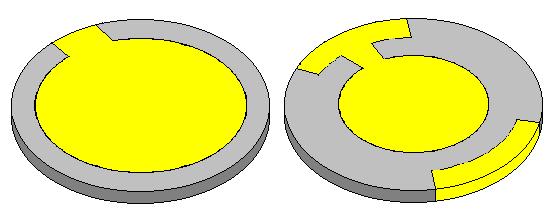The Quartz Crystal Microbalance with dissipation (QCM-D) technique is a mechanical, surface-specific technique that applies shear waves in a quartz crystal to measure the mechanical properties of an adsorbate. These properties include: viscosity, elasticity, density and thickness.
The heart of a QCM instrument is a thin (0.33mm) AT-cut quartz crystal with an electrode on each side.

QCM crystal. Grey=quartz, yellow=metallic electrodes.
When biased with an alternating current, shear waves with anti-nodes at the two surfaces will be generated in the crystal due to the piezoelectric nature of quartz. The crystal is driven at its resonance frequency to get maximum amplitude.
The shear waves of the crystal couple to the surroundings (in this case liquid and maybe an adsorbed layer). Thus, creating exponentially decaying shear waves (decay length appr. 250nm in pure water). This coupling in turn changes the resonance frequency of the quartz crystal, with an amount that is approximately proportional to the mass of the adsorbed layer. Hence, continually measuring the resonance frequency is equivalent to continuously measuring the adsorbed mass. Our QCM equipment supports a time resolution of down to half a second pr. measurement.
By abruptly turning off the alternating current, the oscillations of the crystal will decay exponentially as energy will be dissipated through internal friction in the adsorbate. The measured decay time can be related to the visco-elastic properties of the adsorbed layer.
At iNANO QCM is mainly used to measure mass-uptake, thickness and visco-elastic properties of adsorbed layers during the adsorption of cells and proteins. From these data conformational changes in the internal structure of the layers can be deduced. This information is invaluable in the exploration of binding-behaviour of proteins and cells. Very basic research in the influence of surface roughness on QCM measurements is also being conducted.